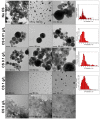Spectroscopic Characterization of Copper-Chitosan Nanoantimicrobials Prepared by Laser Ablation Synthesis in Aqueous Solutions
- PMID: 28336840
- PMCID: PMC5295196
- DOI: 10.3390/nano7010006
Spectroscopic Characterization of Copper-Chitosan Nanoantimicrobials Prepared by Laser Ablation Synthesis in Aqueous Solutions
Abstract
Copper-chitosan (Cu-CS) nanoantimicrobials are a novel class of bioactive agents, providing enhanced and synergistic efficiency in the prevention of biocontamination in several application fields, from food packaging to biomedical. Femtosecond laser pulses were here exploited to disrupt a Cu solid target immersed into aqueous acidic solutions containing different CS concentrations. After preparation, Cu-CS colloids were obtained by tuning both Cu/CS molar ratios and laser operating conditions. As prepared Cu-CS colloids were characterized by Fourier transform infrared spectroscopy (FTIR), to study copper complexation with the biopolymer. X-ray photoelectron spectroscopy (XPS) was used to elucidate the nanomaterials' surface chemical composition and chemical speciation of the most representative elements. Transmission electron microscopy was used to characterize nanocolloids morphology. For all samples, ξ-potential measurements showed highly positive potentials, which could be correlated with the XPS information. The spectroscopic and morphological characterization herein presented outlines the characteristics of a technologically-relevant nanomaterial and provides evidence about the optimal synthesis parameters to produce almost monodisperse and properly-capped Cu nanophases, which combine in the same core-shell structure two renowned antibacterial agents.
Keywords: FTIR; X-ray photoelectron spectroscopy; chitosan; copper nanoparticles; laser ablation.
Conflict of interest statement
The authors declare no conflict of interest. The founding sponsors had no role in the design of the study; in the collection, analyses or interpretation of data; in the writing of the manuscript; nor in the decision to publish the results.
Figures





References
-
- Yang G. Laser Ablation in Liquids: Principles and Applications in the Preparation of Nanomaterials. Taylor & Francis (CRC Press); Stanford, CA, USA: 2012.
-
- Barcikowski S., Menéndez-Manjón A., Chichkov B., Brikas M., Račiukaitis G. Generation of nanoparticle colloids by picosecond and femtosecond laser ablations in liquid flow. Appl. Phys. Lett. 2007;91:83113. doi: 10.1063/1.2773937. - DOI
-
- Petersen S., Jakobi J., Barcikowski S. In situ bioconjugation—Novel laser based approach to pure nanoparticle-conjugates. Appl. Surf. Sci. 2009;255:5435–5438. doi: 10.1016/j.apsusc.2008.08.064. - DOI
-
- Elsayed K.A., Imam H., Ahmed M.A., Ramadan R. Effect of focusing conditions and laser parameters on the fabrication of gold nanoparticles via laser ablation in liquid. Opt. Laser Technol. 2013;45:495–502. doi: 10.1016/j.optlastec.2012.06.004. - DOI
LinkOut - more resources
Full Text Sources
Other Literature Sources
Research Materials

